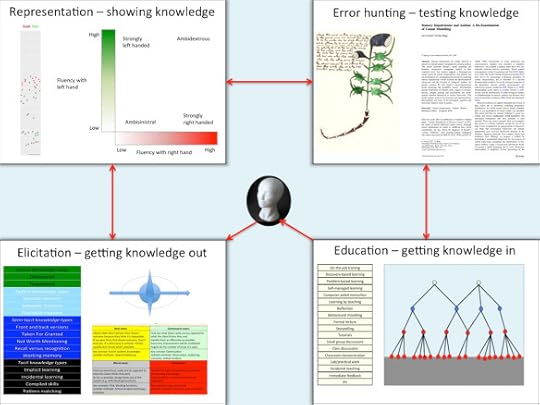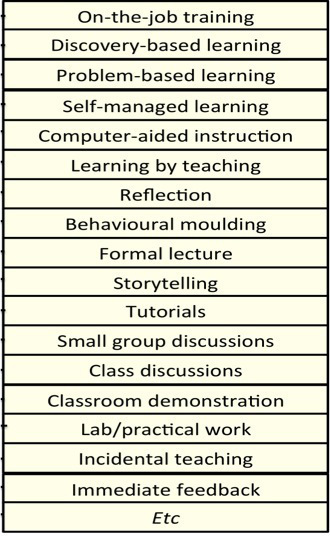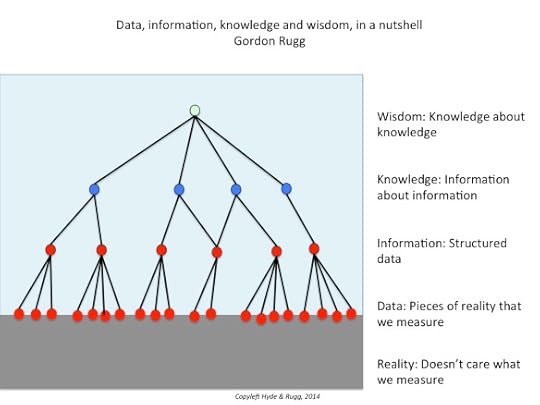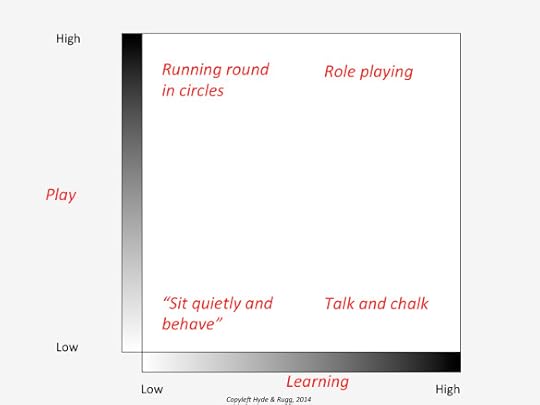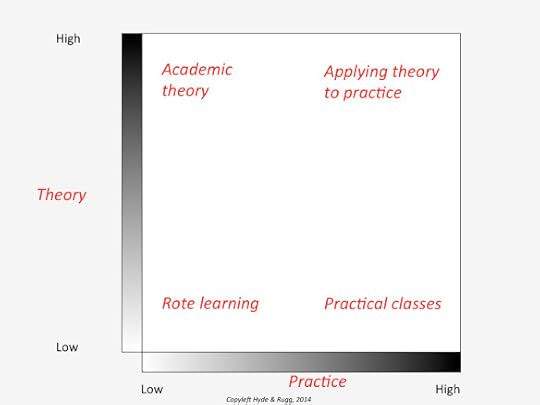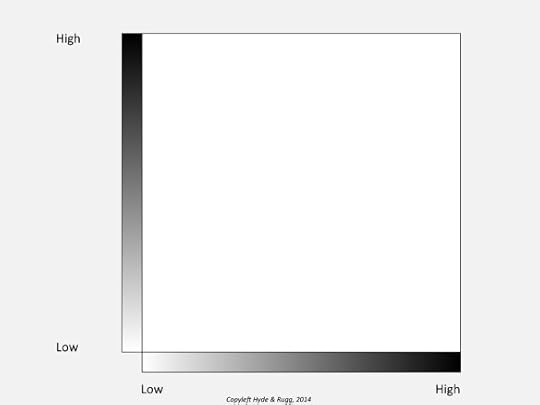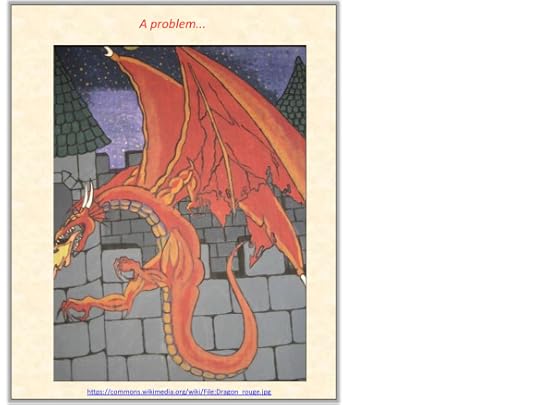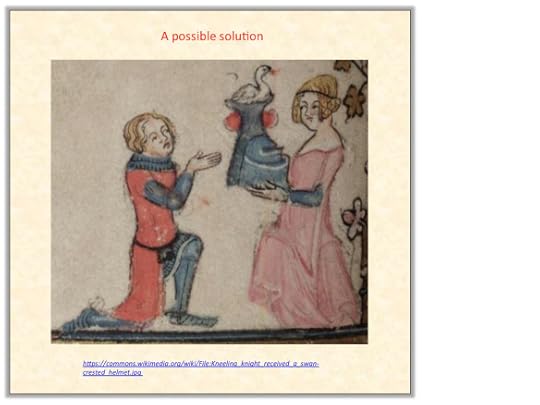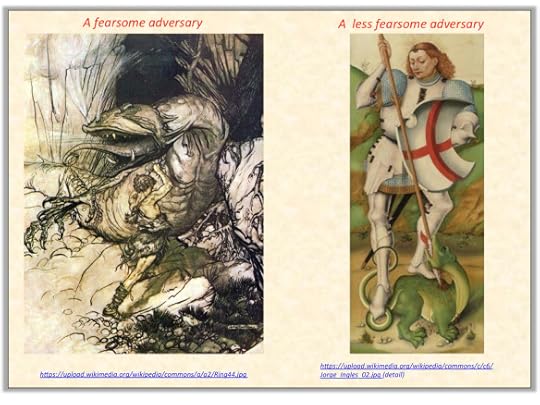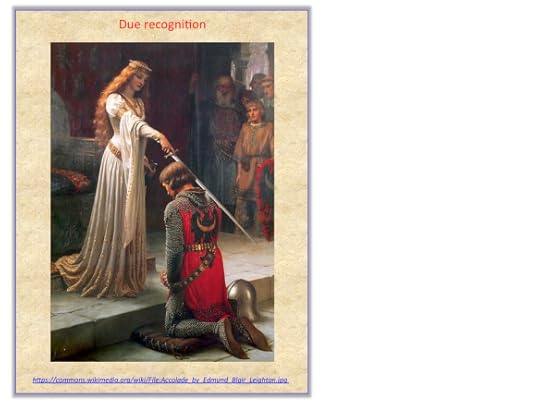Gordon Rugg's Blog, page 19
May 3, 2014
The “compass rose” model for requirements gathering
By Gordon Rugg
If you’re trying to find out the requirements for something, whether it’s a dishwasher or an education system, then a key question is how to make sure you’ve identified all the key issues.
One way is the method described in this article. It involves checking for some key points that establish the boundaries for the requirements, as follows
Best outcomes
Worst outcomes
The most common cases
The beginning
The end
Your official remit
Your unofficial big picture remit
The image below shows these concepts schematically.
This article unpacks these concepts and identifies suitable methods for handling them.
Best outcomes: What would be the dream outcome?
It’s easy to become focused on low-level, short-term goals. Often, problems become simpler and clearer when you look at the top-level dream goals. They tend to be easier to achieve than people think.
One simple but powerful way of finding out someone’s dream outcomes is by using laddering. In essence, it involves repeatedly asking someone why they would want something, so you’re moving up their hierarchy of goals.
For example, when you ask someone what type of job they would like and why, a common answer from students is that they would like a job with a good salary, so that they could afford to travel.
This means that the higher-level goal here is travel, and that the good salary is a means to that end. A simpler way of getting to that end is to find a job which involves being paid to travel. This looks like a dramatic change in plans, but in fact the higher-level goal has remained unchanged; all that has changed is the route to that goal. It’s a lot easier to achieve the goal of a job in travel than the goal of a job with a good salary.
Usually upwards laddering produces a manageably small number of goals – in the order of half a dozen.
Ethical note: This process very rapidly takes you into people’s core values, so you need to be aware of the potential ethical issues, and to stop asking questions if you have moved into sensitive territory.
Worst outcomes: What do you want to avoid at all costs?
Some worst outcomes are already clearly identified by legislation.
Others can be easy to overlook because they’re so familiar that the stakeholders take them for granted and don’t bother to mention them.
Still others are easy to overlook because they are rare.
Each of these categories requires different approaches, and requires attention to different potential problems.
Legislation might appear to be easy to incorporate into an education model, but in practice, the relevant legislation is often misunderstood or only partly known even by education professionals. A classic example is beliefs about legislation relating to school attendance and to home education.
Taken for granted issues are a widespread problem with requirements gathering in general. They are particularly likely to involve fundamental concepts, that are taken for granted precisely because they’re so fundamental and familiar that it’s hard to imagine them not being there.
Rare cases often have major effects, even though they are rare. Often, they become landmark cases that prompt changes in legislation, with a view to preventing a particular outcome from ever happening again.
The risk here is that the undesirable outcome will be identified correctly, but that the underlying cause will be misidentified, and that the legislation will be trying to fix the wrong problem.
There are various well-established techniques for handling rare cases, such as critical incident technique, which was developed specifically for this type of problem. Scenarios are also useful for working systematically through possibilities that might occur. In addition, laddering can be used to identify undesired outcomes and to unpack the reasons for which they are not desired.
Commonest cases: Which categories account for about 80% of the cases?
There’s a widespread phenomenon known as the Pareto distribution (after the researcher who identified it) or the 80/20 distribution (after the nature of the distribution). Very often, 20% of one thing will account for 80% of something else. For instance, a common finding is that 20% of your product range generates about 80% of your income. Similarly, about 80% of the time that users spend on your website will typically be spent on just 20% of the website.
If you can identify those disproportionate cases, and develop smoothly efficient ways for handling them, then you can significantly reduce the amount of time you spend on them, and significantly increase the amount of time that you can spend on the other cases.
There are various ways of improving processes, whether via process modelling, sociotechnical approaches, physical ergonomics or cognitive ergonomics. Although the names may sound intimidating, the underlying concepts are easy to grasp and apply, and there’s a lot of easily accessible literature about them.
Beginning to end: What is the complete process into which your product or service fits?
It’s a good idea to look at the complete process, because this will often bring out issues that can significantly affect your requirements.
A classic example is a seasonal peak in usage, such as postal services having to cope with a sudden massive increase in demand every Christmas. Similarly, universities and schools have to cope with sudden large influxes of new students every autumn.
Another classic example is remembering to design physical products with forethought about cleaning and maintenance, rather than viewing those issues as someone else’s problem. There’s not much point in designing a product that’s easier to use, if that product will take twice as long to clean or maintain as its competitors.
This relates closely to the next two points, about the boundaries of your remit.
Your official remit: Where do your responsibilities officially begin and end?
It’s wise to check what your official responsibilities actually are, rather than just doing the same as everyone else in the field. Otherwise, there’s a horrible risk that you’ll be caught without a defence when someone sues you for negligence; claiming that everyone else is equally culpable isn’t exactly the strongest position in law. Even if you don’t end up being sued, there’s still a strong chance that you’ll end up having to retro-fix something you produced so that it conforms to a tightening up in enforcement of regulations (e.g. accessibility of web pages for users with visual impairment). It’s better to get it right first time round.
Your unofficial big picture remit: What could you add to your remit to make life easier for everyone, including yourself?
Paradoxically, you can often make life easier for yourself by getting involved with things that aren’t officially your problem.
For instance, if you’re an architect tasked with designing a waiting room for a medical practice, then you might quite legitimately argue that the IT provision isn’t your problem. However, if you talk with the IT provider, you will probably be able to include features in your architectural design that will make things better for everyone – for instance, by designing the room layout so that it’s easy for everyone in the room to see the screen that shows the appointments.
It’s wise to watch out for legal implications if you extend your remit unofficially, since there’s a risk of getting into territory for which you don’t have proper training or insurance. However, if handled with care, this approach of going an extra mile can make life much better for everyone, including yourself.
Conclusion
This is a brief overview of how you can look at the requirements for your product or service from several directions, to improve your coverage of key requirements. You won’t catch all the possible requirements – that simply isn’t possible, since they’re potentially infinite – but your coverage will be broad enough, deep enough and systematic enough to give you a solid foundation.
Notes
You’re welcome to use Hyde & Rugg copyleft images for any non-commercial purpose, including lectures, provided that you state that they’re copyleft Hyde & Rugg.
There’s more about the theory behind this article in Gordon’s latest book:
Blind Spot, by Gordon Rugg with Joseph D’Agnese
http://www.amazon.co.uk/Blind-Spot-Gordon-Rugg/dp/0062097903
Related articles:
http://hydeandrugg.wordpress.com/2014/03/09/finding-out-what-people-want-in-a-nutshell/
http://hydeandrugg.wordpress.com/2013/09/09/client-requirements-the-shape-of-the-elephant-part-4/
http://hydeandrugg.wordpress.com/2013/09/06/client-requirements-the-shape-of-the-elephant-part-3/
http://hydeandrugg.wordpress.com/2013/09/05/client-requirements-the-shape-of-the-elephant-part-2/
http://hydeandrugg.wordpress.com/2013/09/05/client-requirements-the-shape-of-the-elephant-part-1/
http://hydeandrugg.wordpress.com/2013/05/27/the-verifier-approach-part1/


May 2, 2014
Friday Funny: Elk Hunting 101
By Julius Caesar (with Gordon Rugg)
XXVII.–There are also [animals] which are called elks. The shape of
these, and the varied colour of their skins, is much like roes, but in
size they surpass them a little and are destitute of horns, and have
legs without joints and ligatures; nor do they lie down for the purpose
of rest, nor, if they have been thrown down by any accident, can they
raise or lift themselves up. Trees serve as beds to them; they lean
themselves against them, and thus reclining only slightly, they take
their rest; when the huntsmen have discovered from the footsteps of
these animals whither they are accustomed to betake themselves, they
either undermine all the trees at the roots, or cut into them so far
that the upper part of the trees may appear to be left standing. When
they have leant upon them, according to their habit, they knock down by
their weight the unsupported trees, and fall down themselves along with
them.
[From Caesar, C.J. De Bello Gallico. Project Gutenberg; Everyman's Library version, 1915 edition, translated by W.A. MacDevitt.]


April 28, 2014
One hundred Hyde & Rugg articles, and the Verifier framework
By Gordon Rugg
This is the 100th post on the Hyde & Rugg blog. We’re taking this opportunity to look back at what we’ve covered and look forward to what comes next.
The image below shows some of the main themes and outputs so far, in the “knowledge cycle” format that underlies our Verifier framework for tackling human error. If you’ve come to this blog after reading Blind Spot, you might be pleased to discover that we’ve been covering the contents of Verifier here in more depth than was possible in the book, and that we’re well on the way to a full description.
In the image below you can see some of the main themes and topics we’ve covered so far in the “knowledge cycle” format that underlies our Verifier framework for tackling human error. If you’ve come to this blog after reading Blind Spot, it’s worth knowing that we’ve covered some of the the contents of Verifier in more depth here than was possible in the book, and that we’re well on the way to a full description.
The knowledge cycle, and topics that we’ve blogged about
The knowledge cycle shows how the main themes of our work fit together.
One theme involves getting knowledge out of people. We’re particularly interested in knowledge that people find difficult to put into words, where questionnaires and interviews simply can’t tackle the problem. A lot of our work involves eliciting and clarifying requirements for products and services; we’re also interested in the mirror image of this, namely design of products and services that meet user’s requirements.
A second major theme is representing knowledge – how best to visualise and categorise it. The Search Visualizer software is an example of how this can provide new ways of handling long-running problems. We’ve also looked at categorisation and classification, applied to a range of areas that include gender categorisation and use of space.
The third main theme is testing knowledge. There are large and well-established literatures on human error, logic, etc, that we’ve treated as foundational for our work – we haven’t tried to re-invent the wheel. Our work in this area has concentrated oncase studies where we’ve applied the Verifier framework to long-standing problems, such as the Voynich Manuscript and the literature on autism. In both those cases, we’ve published articles in the top relevent journals, as a way of checking that our findings provide solid new insights.
The fourth major theme is getting knowledge in to the human brain, thereby completing the knowledge cycle. Our work here has so far focused on filling gaps in the existing education literature, principally in two areas. The first of these is types of memory, knowledge, skill, etc, with particular reference to semi-tacit and tacit knowledge, and to the implications of these for delivery and learning methods. The second is the crucial distinction between serial processing and parallel processing/pattern matching, which has enormous implications for teaching and learning, but which appears to have received little attention in the education literature.
I’ve linked to articles from each of these areas at the end of this article.
Coming soon:
Requirements
The “compass rose” model of requirements gathering: A simple way of catching the main requirements for a product or service
Method fragments: What are the basic components of elicitation techniques?
Sociotechnology: How technology and human behaviour interact with each other
Representation
A framework for matching types of knowledge onto appropriate representations
More about categorisation, gender and sexuality
Nonverbal signage: How to help people find their way around
Error
The mathematics of desire: How much is too much?
Using visualisations to reduce error
Education
Method fragments for education methods: What are the underlying components of teaching and learning methods?
Serial processing versus parallel processing/pattern matching
A worked example: Applying knowledge modelling concepts to teaching and learning
Notes
You’re welcome to use Hyde & Rugg copyleft images for any non-commercial purpose, including lectures, provided that you state that they’re copyleft Hyde & Rugg.
Blind Spot, by Gordon Rugg with Joseph D’Agnese
http://www.amazon.co.uk/Blind-Spot-Gordon-Rugg/dp/0062097903
Previous articles, by topic
(There are other articles on other topics, such as humour; the list below contains our main articles relating to Verifier.)
Requirements and design
Requirements:
http://hydeandrugg.wordpress.com/2014/03/09/finding-out-what-people-want-in-a-nutshell/
http://hydeandrugg.wordpress.com/2013/09/09/client-requirements-the-shape-of-the-elephant-part-4/
http://hydeandrugg.wordpress.com/2013/09/06/client-requirements-the-shape-of-the-elephant-part-3/
http://hydeandrugg.wordpress.com/2013/09/05/client-requirements-the-shape-of-the-elephant-part-2/
http://hydeandrugg.wordpress.com/2013/09/05/client-requirements-the-shape-of-the-elephant-part-1/
http://hydeandrugg.wordpress.com/2013/05/27/the-verifier-approach-part1/
Elicitation techniques:
http://hydeandrugg.wordpress.com/2013/07/01/reports-a-brief-overview/
http://hydeandrugg.wordpress.com/2013/07/02/think-aloud-technique-a-brief-introduction/
http://hydeandrugg.wordpress.com/2013/06/11/a-card-sorts-tutorial/
Design:
http://hydeandrugg.wordpress.com/2014/02/11/parsing-designs-and-making-designs-interesting/
http://hydeandrugg.wordpress.com/2014/02/01/making-designs-interesting/
http://hydeandrugg.wordpress.com/2014/02/01/making-designs-interesting/
http://hydeandrugg.wordpress.com/2013/08/27/decision-rationale-the-why-and-the-wherefore/
Representation
http://hydeandrugg.wordpress.com/2013/06/01/the-verifier-framework-visualisation/
http://hydeandrugg.wordpress.com/2013/05/30/an-introduction-to-graph-theory/
http://hydeandrugg.wordpress.com/2013/05/30/an-introduction-to-facet-theory/
Three articles about visualisations of gender and how these overlap with art:
http://hydeandrugg.wordpress.com/2013/10/24/gordons-art-exhibition-part-2/
http://hydeandrugg.wordpress.com/2013/10/12/gordons-art-exhibition-part-1/
http://hydeandrugg.wordpress.com/2013/10/05/gordons-art-exhibition-visualisations-women-and-epics/
Error
http://hydeandrugg.wordpress.com/2014/02/18/parsing-landscapes-and-art-some-speculations/
The Voynich Manuscript:
http://hydeandrugg.wordpress.com/2014/02/28/voynich-articles-overview/
http://hydeandrugg.wordpress.com/2013/08/20/hoaxing-the-voynich-manuscript-part-4-the-materials/
http://hydeandrugg.wordpress.com/2013/07/23/hoaxing-the-voynich-manuscript-part-1/
http://hydeandrugg.wordpress.com/2013/06/22/verifier-voynich-and-accidental-complexity/
A series about the D’Agapeyeff Cipher:
http://hydeandrugg.wordpress.com/2013/08/16/a-very-british-mystery-part-5-gavin-finds-a-typo/
http://hydeandrugg.wordpress.com/2013/08/12/a-very-british-mystery-part-4-quiet-bodies/
Education
http://hydeandrugg.wordpress.com/2014/04/25/how-complex-should-education-theories-be/
http://hydeandrugg.wordpress.com/2014/04/13/an-education-framework-based-on-knowledge-modelling/
http://hydeandrugg.wordpress.com/2014/04/21/compiled-skills-and-education-theory/
http://hydeandrugg.wordpress.com/2014/04/01/teaching-the-facts/
http://hydeandrugg.wordpress.com/2014/03/30/just-the-facts/
http://hydeandrugg.wordpress.com/2014/03/23/false-dichotomies-in-education-theory/
http://hydeandrugg.wordpress.com/2013/05/27/the-verifier-approach-part1/
http://hydeandrugg.wordpress.com/2014/03/19/visions-of-course-structure/
http://hydeandrugg.wordpress.com/2014/02/27/what-are-craft-skills-a-brief-overview/
There is more material about these topics on our other sites:
http://searchvisualizer.wordpress.com/
http://www.searchvisualizer.com/


April 25, 2014
How complex should education theories be?
By Gordon Rugg
There’s an old joke in the physical sciences, often attributed to Einstein, that a model should be as simple as possible but no simpler.
The converse is that a model should be as complex as necessary, but no more complex.
In this article, I’ll discuss what the most useful level of complexity is for education theories.
 Clarity emerging from the fog: Cropped image from wikimedia
Clarity emerging from the fog: Cropped image from wikimedia
Some models of education attempt to divide issues into two or three sharply divided categories, such as “progressive education” versus “traditional education”. There’s an opposing view which claims that the whole topic is intractably complex, and that the best we can hope for is some areas of general agreement within a fog of personal opinions.
The diagram below shows humorously what these viewpoints would look like if applied to models of timekeeping. One is a binary, either/or viewpoint, with time sharply divided into the two categories of “day” and “night”. The other is an extreme subjectivist haze, where there are no absolutes or certainties.
Beneath the humour, there’s a serious point. Is it possible to identify an optimal level of complexity for models of education, and if so, how could we set about doing it?
How other fields have tackled this problem
The field of zoology provides some instructive insights into how we can make sense of a very large problem area. There were numerous false starts, but eventually Linnaean classification provided a framework that was simple in its underlying principles and yet powerful enough to handle millions of different species. One core concept is the tree of life. The illustration below shows this concept.
This diagram might look horribly complex, but it isn’t. It’s big – it has to be, to handle several million species – but the underlying structure consists of a very few, very simple concepts.
Here’s how it works. One core concept is that a higher-level category, such as X below, can be divided into lower-level categories, such as Y and Z below. In classic Linnaean taxonomy, there are about seven levels; more recent taxonomies have more, but not enormously more, as in the example above, which goes to about ten levels.
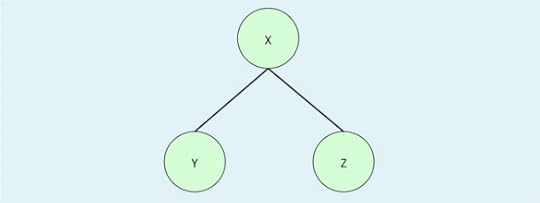 Image copyleft Hyde & Rugg 2014
Image copyleft Hyde & Rugg 2014
The next core concept is that at each level, each category has one or more defining attributes unique to it, such as “has feathers”. Each category also inherits the defining attributes of its parents, so the category of “bird” will inherit categories such as “is warm blooded” and “has a bony skeleton” from the higher-level categories from which it is derived. The illustration below shows the principle.
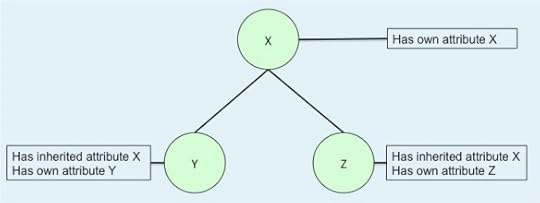 Image copyleft Hyde & Rugg 2014
Image copyleft Hyde & Rugg 2014
The subdividing stops at the level of “species”. This is the last core concept.
I’ve laboured this point to show that an enormous problem space can be reduced to a very small number of core components that have enormous explanatory and predictive power.
Conversely, an apparently simple problem, such as telling the precise time, can require a model with a large number of components, such as a mechanical clock.
The image above shows part of an astronomical clock. It looks complex, and it is complex. However, there are three features of the clock that are easy to overlook, but that have profound implications.
One is that although the clock mechanism is complex, it isn’t vague. Each part is precisely machined and is in precisely the right place; otherwise the clock wouldn’t work. Similarly, just because a theoretical model of something such as education might be complex, that doesn’t mean that the component parts of that model need to be vague. On the contrary, the more accurately defined the component parts are, the better the model is likely to work.
The second key feature is that although there are many parts, they can be classified into a much smaller number of discrete categories, such as gear and spring. As with the zoological taxonomy example, good categorisation can make a problem much simpler.
The third key feature is that mechanical clocks are accurate because they are complex. They need to be as complex as they are in order to do their job. It’s the same with models of how the kidneys work or of how the brain processes information. Sometimes there just isn’t a simple way of modelling something; you need to accept the complexity and get on with it.
The diagram below shows this as a third way between the “night and day” simple binary model, and the “vague subjective haze” model with no fixed points.
So what are the components that are required for a working model of education?
Issues that a model of education needs to handle
If we look at what happens during an individual chunk of education, such as learning some small set of information about the Vikings in history, then that gives us an insight into which issues are involved.
We can divide what happens in a chunk of education into three main parts:
What goes in
How it goes in
What happens to it along the way
What goes in consists of information in the broadest sense.
There’s a well-established pyramid of knowledge classification, which involves slicing the information into four levels, as in the diagram below.
This was the topic of one of our previous articles:
(We’ve modified the previous version of this diagram slightly for simplicity and clarity.)
Another way of slicing up information in the broadest sense is the division into future/explicit/semi-tacit/tacit knowledge, from requirements engineering. This involves about fifteen bottom-level categories, as in the diagram below.
Image copyleft Hyde & Rugg 2014
This was the topic of another of our previous articles:
http://hydeandrugg.wordpress.com/2014/04/13/an-education-framework-based-on-knowledge-modelling/
That gives us a total of about twenty concepts for the “input” part of the process, grouped into about eight categories. That’s not an enormous number, and it’s composed of clearly defined components.
How it goes in involves the delivery mechanism – in other words, the learning and/or teaching method being used for a particular piece of information.
The delivery mechanism can be divided into different methods of teaching, training and learning. Although there are large numbers of different named methods, the number of underlying concepts is smaller. In the diagram below, we’ve listed just under twenty approaches as examples. We’re working on a unifying framework for delivery mechanisms, and it looks likely to end up with about as many components as the knowledge framework, i.e. about twenty, organised into a handful of categories.
Image copyleft Hyde & Rugg 2014
Our previous article on compiled skills shows an example of how the matching between a particular knowledge type and appropriate delivery mechanisms can be handled.
http://hydeandrugg.wordpress.com/2014/04/21/compiled-skills-and-education-theory/
What happens to it along the way is that the information is interpreted and assimilated, with varying degrees of fidelity. Things often go wrong.
What goes wrong can be divided into physical problems, mental misunderstandings, and a combination of both.
Physical problems contain sensory problems and information processing problems. Humans have around twenty different senses, with the precise number depending on the definition you use, which can be divided into a handful of categories. The category of “touch,” for instance, contains separate sensory systems that handle kinaesthesia (knowing where each part of the body is), heat reception, light touch and deep touch, among others. Again, these categories can be clearly differentiated, at the anatomical level, and have very practical implications.
Misunderstandings have been researched in some depth in fields such as naïve physics and the psychology of programming, as well as in the broader field of mental models. Again, the number of key categories is tractably small, although the number of specific low-level examples is large. There are various formal taxonomies of error, and they typically contain a few dozen categories at most.
So how complex does an education theory need to be?
Adding together the rough figures above, we get the answer that an education theory needs to include about a hundred categories relating to knowledge types, delivery types, and processing issues. (An education theory should also cover issues such as curriculum, syllabus, etc, but in this article I’m focusing specifically on knowledge, delivery and processing.)
The figure of about a hundred categories might look forbiddingly high, but to put it in context, that’s fewer than the number of parts in a good quality mechanical clock.
The numbers are approximate, but they’re likely to be in the right order of magnitude, as we’ll see in the next article. We’re talking about one or two hundred categories, rather than one or two thousand. It’s a tractable number. It’s well within the number of categories that a professional in other fields would be expected to know well – for instance, an ornithologist would easily be able to distinguish hundreds of different types of bird, and an interpreter would be expected to have a vocabulary of tens of thousands of words in each language. The literature on expertise has consistently found that experts in a given discipline know at least tens of thousands of chunks of information about their area of expertise, richly organised and categorised, so we should expect the same from experts on education.
This gives us a starting point for constructing a model of education; we know roughly how complex it needs to be, and we know some of the key items that it needs to include.
This doesn’t, however, tell us how the parts should fit together, or whether there might be other parts that we’ve missed.
In our next article, we will tackle those questions by looking at ways of establishing the boundaries for an education theory.
Notes
You’re welcome to use Hyde & Rugg copyleft images for any non-commercial purpose, including lectures, provided that you state that they’re copyleft Hyde & Rugg.
There’s more about the theory behind this article in Gordon’s latest book:
Blind Spot, by Gordon Rugg with Joseph D’Agnese
http://www.amazon.co.uk/Blind-Spot-Gordon-Rugg/dp/0062097903
Related articles:
http://hydeandrugg.wordpress.com/2014/04/13/an-education-framework-based-on-knowledge-modelling/
http://hydeandrugg.wordpress.com/2014/04/21/compiled-skills-and-education-theory/
http://hydeandrugg.wordpress.com/2014/03/23/false-dichotomies-in-education-theory/
http://hydeandrugg.wordpress.com/2013/05/27/the-verifier-approach-part1/
Rugg, G. & Gerrard, S. (2009). Choosing appropriate teaching and training techniques. International Journal of Information and Operations Management Education 3(1) pp. 1-11.
Rugg, G., D’Cruz, B., Foreman-Peck, L., Grimshaw, E., Guilford, S., Roberts, S. & Tonglet, M. (2008). Selection and use of elicitation techniques for education research. International Journal of Information and Operations Management Education 2(3) pp. 235-254.
Links and sources
https://commons.wikimedia.org/wiki/File:EarthRender_%28square%29.png
https://commons.wikimedia.org/wiki/File:Fog_shadow_of_GGB.jpg
https://en.wikipedia.org/wiki/Tree_of_life


April 21, 2014
Compiled skills and education theory
By Gordon Rugg
In a previous article, we described a framework for mapping different types of knowledge (in the broadest sense) onto different methods of teaching, training and learning (also in the broadest sense).
http://hydeandrugg.wordpress.com/2014/04/13/an-education-framework-based-on-knowledge-modelling/
That article was a broad overview. This article shows a worked example of how the framework operates for one category from the framework, namely compiled skills.
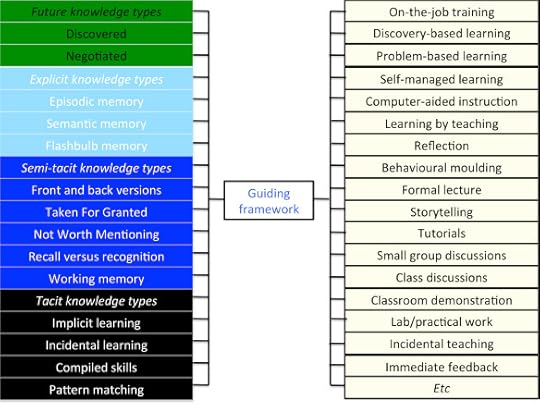 Image copyleft Hyde & Rugg, 2014
Image copyleft Hyde & Rugg, 2014
Compiled skills are a type of strictly tacit knowledge that have traditionally been viewed in the education world as something of a black box. They are particularly problematic for some views of education because their performance is usually adversely affected, or completely disrupted, by any attempt to verbalise them. For any sport enthusiast, they are a familiar phenomenon, usually under the name of “the flow” or of “muscle memory”.
This article unpacks the nature of compiled skills, and examines the implications for education theory and practice.
Compiled skills are skills that were once explicit (i.e. accessible to reasonably valid introspection – in other words, the student would know just what actions he or she was carrying out) but that have subsequently been so highly practised that they no longer involve conscious deliberate monitoring of the individual activities. Some examples are:
Riding a bicycle
Changing gear in a car
Touch typing
Writing with a pen
The fact that these skills were once explicit is what differentiates them from implicit learning, where a skill is acquired without ever going through a stage where the knowledge involved is explicit.
The presence of an explicit stage has various advantages from an educational viewpoint. For instance, a driving instructor can explain the rationale behind a particular sequence of actions to the learner driver. This is particularly useful when giving instruction about rare and/or dangerous situations.
Identifying a compiled skill
A simple way of checking whether or not an activity involves compiled skills is to try having a conversation with the person carrying out that activity. If they are able to have an intelligent conversation during the activity without noticeable problems, then compiled skills are probably involved. For example, a skilled driver or cyclist will be able to conduct a perfectly normal conversation while changing gear or riding a bike.
The situation is slightly more complicated when the skill involves a verbal component, as with touch typing (i.e. typing without needing to look at the keyboard) and writing with a pen. In these cases, the activity itself will interfere with having a conversation, so the “intelligent conversation” test can’t be applied. The give-away in such cases involves a key feature of compiled skills, namely speed.
Touch typists are a good example of this feature. A skilled touch typist can type significantly faster than would be possible if they consciously checked the position of each finger and each key for each keystroke. That’s why I learnt how to touch type; I’d hit the ceiling for speed with “hunt and peck” two fingered typing, and to go any faster, I had to compile the skill.
Compiling a skill
The early stages of compiling a skill are usually slow and error-prone, as anyone who has ever driven behind a learner driver can testify. With practice, though, the learner becomes more fluent, carrying out the activity faster and with fewer mistakes. Eventually the activity becomes fully compiled, and can be carried out without any conscious action in the process. (I’ve deliberately avoided using words such as automatic, subconscious and instinctive, since those come with heavy intellectual baggage of connotations that I want to avoid for the moment.)
The name compiled skills comes from cognitive psychology and Artificial Intelligence. It’s explicitly based on the concept of compiling software, thereby transforming it from a slow format that humans can easily understand into a much faster format that humans can’t easily understand. This appears to be a similar process to the one involved in human compiled skills.
Advantages and limitations
Compiled skills are typically fast and fluent, with few errors. Those are big advantages.
There’s also another big advantage that comes with compiled skills. The fact that they don’t require conscious thought means that they leave more cognitive capacity available for other activities to go on at the same time. A classic example is a skilled driver, who can use compiled skills to handle the physical activities of driving, while concentrating mentally on assessing what’s happening on the road ahead – for instance, deciding whether there’s enough space to overtake a cyclist safely.
There are also disadvantages that come with compiled skills.
One disadvantage is that they are prone to strong but wrong errors. These occur when a person does something familiar as a result of over-strong habit, rather than doing the right thing. A classic example is trying to unlock a door with the wrong key; the usual pattern is to choose a frequently-used key, rather than the correct one.
This has been well recognised in some fields for centuries. The French phrase for an unexpected deadly blow, a coup de Jarnac, dates from a duel in 1547 where Guy Chabot de Jarnac lured his opponent into a strong but wrong error, and then attacked with a devastating blow that he had practised until it was a compiled skill.
In some safety-critical systems, designers deliberately introduce blocking functions to prevent users from committing strong but wrong errors.
Another disadvantage of compiled skills is that they can be severely or completely disrupted by any attempt to think about them while using them. Again, this is well known in competitive sports, and is part of the reason for the cliché in martial arts movies about the student needing to focus on doing, not thinking.
Images from wikimedia and wikipedia
Implications for teaching, training and learning
Compiled skills are ubiquitous and invaluable. They are usually faster and more accurate than the corresponding uncompiled version of the same skill. They also free up the user’s conscious cognition for other activities such as higher-level monitoring and planning.
A key feature of compiled skills that has significant practical implications for education is the time that they require to develop. Skill compilation requires a lot of practice over a significant amount of time – typically weeks, rather than days or hours.
This can be a real problem in cases such as children learning to write, where the child cannot reasonably be expected to move on to activities such as creative writing if they have not yet managed to compile their handwriting skills.
Another key feature of compiled skills with significant implications for education is that attempting to introspect into a compiled skill will make the student’s performance worse, not better. Although there are situations where student reflection is a commendable activity, those situations do not include compiled skills.
A third feature of compiled skills with implications for education is assessment. Compiled skills by definition cannot be validly assessed using verbal introspective methods such as examinations or multiple-choice tests; they can only be validly assessed via methods that are based on physical performance.
Conclusion
This article does not aim to give an exhaustive description of compiled skills and their educational implications.
However, it does give an example of how the framework above can give specific practical and theoretical insights into a particular knowledge type and its implications for education, based on empirical evidence from the literature.
We will examine other cases in later articles.
Notes
You’re welcome to use Hyde & Rugg copyleft images for any non-commercial purpose, including lectures, provided that you state that they’re copyleft Hyde & Rugg.
The duelling image is from wikimedia:
https://commons.wikimedia.org/wiki/File:Suevia_%28IV%29_v_Rhenania_1836.jpg
The martial arts image is from wikipedia:
https://en.wikipedia.org/wiki/File:Steven_Ho_Martial_Arts_Kick.jpg
There’s more about the theory behind this article in Gordon’s latest book:
Blind Spot, by Gordon Rugg with Joseph D’Agnese
http://www.amazon.co.uk/Blind-Spot-Gordon-Rugg/dp/0062097903
Related articles:
http://hydeandrugg.wordpress.com/2014/04/13/an-education-framework-based-on-knowledge-modelling/
http://hydeandrugg.wordpress.com/2014/03/23/false-dichotomies-in-education-theory/
http://hydeandrugg.wordpress.com/2013/05/27/the-verifier-approach-part1/
Rugg, G. & Gerrard, S. (2009). Choosing appropriate teaching and training techniques. International Journal of Information and Operations Management Education 3(1) pp. 1-11.
Rugg, G., D’Cruz, B., Foreman-Peck, L., Grimshaw, E., Guilford, S., Roberts, S. & Tonglet, M. (2008). Selection and use of elicitation techniques for education research. International Journal of Information and Operations Management Education 2(3) pp. 235-254.


April 13, 2014
An education framework based on knowledge modelling
By Gordon Rugg
Education is about getting new content into student’s heads, via some combination of teaching and learning.
In order to do this in an evidence-based way, one key element is a solid categorisation framework for each of the variables involved. Three key variables are:
Types of content
Types of delivery
Types of learning
There are other important variables, such as physiological constraints, but we’ll focus for the moment on the three listed above.
Existing educational categorisations, such as the Visual/Auditory/Kinaesthetic model, tend to be unsystematic and/or very coarse-grained. In order to handle this area properly, a category system should as a minimum be able to handle systematically the types of content and of delivery and learning shown in the diagram below, and preferably be able to handle more.
This article is a brief overview of how we have been tackling this issue. We will go into more detail in later articles.
In the diagram above, the categorisation of content is the same one that Neil Maiden and I used in our work on requirements acquisition, in our ACRE framework.
That framework contains four main types of content (which we called “knowledge” as a shorthand term for various forms of content, communication and skill) and a way of mapping each of these onto appropriate methods for eliciting that type of knowledge from a respondent.
The first of these types, future systems knowledge, is a significant issue for product development, where the client often cannot know what their detailed requirements will be, since they are dealing with a novel product that does not currently exist.
In education, this issue is highly salient for students choosing academic options and career paths, where by definition the students will not initially have enough information to make an informed choice, and where there has to be an iterative process of information-gathering, partial choice, and further information-gathering.
Explicit knowledge in this framework is knowledge to which the individual has reasonably accurate access via introspection. For example, when the student remembers the date of a particular event, they are drawing on explicit knowledge.
Explicit knowledge is liable to various well-established biases and distortions. Human memory is fragile and liable to distortion both when storage occurs and when memories are retrieved, as shown by a substantial body of work by researchers such as Elizabeth Loftus and Alan Baddeley. For instance, simply altering the wording of a question can significantly change a respondent’s memories for what they saw.
A lot of the content in education is explicit, but even more content is not explicit. Simply lumping this other content into a single dustbin category of “tacit” or “subconscious” is not very helpful. The next two parts of the ACRE framework identify two main categories and various sub-categories that involve content which is not explicit.
Semi-tacit knowledge is accessible via some routes, but not via all routes, unlike explicit knowledge.
A classic example is recognition (passive memory) versus recall (active memory). If you ask a student to list all the countries of Europe, they will usually produce a partial list. If you then show them a mixture of real countries that they haven’t named and of imaginary or non-European countries, the student will usually be able to identify accurately a number of other European countries that they had not been able to recall initially. It’s clear from the fact of recognition that the knowledge was in the student’s brain, but despite this, the student was not able to access it consciously. This isn’t an issue of motivation – quiz shows are an everyday example of people being unable to recall information that they know, even though there are large incentives to recall it. Instead, it’s an issue of how human memory works.
There are various types of semi-tacit memory; for brevity, I won’t go into them here, but we’ll blog about them in later articles. If you want to do some background reading, the types listed in the diagram are all based on well-established concepts from the literature, that can be easily found online.
Tacit knowledge in this framework is knowledge to which the individual has no valid introspective access – in other words, the person can use the knowledge (or skill, or whatever) but does not actually know just how they are using it, or what it is. A classic example is an experienced driver changing gear without knowing exactly which actions they perform in which sequence.
This definition of tacit knowledge is stricter than the one often used in the business literature, where “tacit” covers both the strictly tacit knowledge described above and also the semi-tacit types described above.
Tacit knowledge often involves muscle memory and/or very large amounts of practice and rehearsal, with significant implications for learning and delivery.
Learning and delivery types
An education theory should not only have an adequate categorisation system; it should also have an empirically grounded framework that guides the matching of particular types of content with appropriate types of delivery and learning.
In the ACRE framework, Neil Maiden and I mapped the various types of knowledge onto appropriate techniques for eliciting each type of knowledge.
In more recent work, Sue Gerrard and I have started to examine ways of mapping various knowledge types onto appropriate techniques for learning and teaching each of the knowledge types.
We have also drawn on the Verifier framework of human error, described in my book Blind Spot, to identify ways of making key content more memorable by using biases in human memory as an asset.
This article is a preliminary overview of our approach.
We’ll be exploring some of these issues in detail in future articles.
Notes
The image above is copyleft Hyde & Rugg. You’re welcome to use our copyleft images for any non-commercial purpose, including lectures, provided that you state that they’re copyleft Hyde & Rugg.
There’s more about the theory behind this article in my latest book:
Blind Spot, by Gordon Rugg with Joseph D’Agnese
http://www.amazon.co.uk/Blind-Spot-Gordon-Rugg/dp/0062097903
Related articles:
http://hydeandrugg.wordpress.com/2014/03/23/false-dichotomies-in-education-theory/
http://hydeandrugg.wordpress.com/2013/05/27/the-verifier-approach-part1/
Rugg, G. & Gerrard, S. (2009). Choosing appropriate teaching and training techniques. International Journal of Information and Operations Management Education 3(1) pp. 1-11.
Rugg, G., D’Cruz, B., Foreman-Peck, L., Grimshaw, E., Guilford, S., Roberts, S. & Tonglet, M. (2008). Selection and use of elicitation techniques for education research. International Journal of Information and Operations Management Education 2(3) pp. 235-254.
Maiden, N.A.M. & Rugg, G. (1996). ACRE: a framework for acquisition of requirements. Software Engineering Journal, 11(3) pp. 183-192.


April 1, 2014
Teaching the facts
By Gordon Rugg & Sue Gerrard
There’s a lot of debate in education about “teaching the facts”.
There’s also a lot of debate about the definition of “facts” and about the nature of teaching.
However, a couple of things tend to be conspicuous by their absence in these debates.
There’s a significant absence of numbers relating to facts, such as how many facts a student should know about a particular topic.
There’s also a significant absence of categorisation systems that use more than three categories.
These absences are usually indications that a debate is focused on questions that aren’t going to produce useful answers.
So what happens when you plug in some numbers, and some richer categorisation?
In brief, you get this:
students need to learn between one thousand and ten thousand facts
there’s an upper limit of learning of about ten facts per hour, and
you need to distinguish between about ten to twenty different types of “fact”.
These results have far reaching implications for education. They’re the topic of this article.
How many facts?
There’s been quite a lot of research into expertise over the last few decades, and that research has produced a range of solid and consistent findings. One of the most surprising to anyone new to this literature is the sheer volume of information that experts know compared to novices. Experts aren’t experts because they’re more intelligent or more logical; they’re experts because they know huge amounts.
One of the first researchers to investigate this area was de Groot. He and his co-researchers studied chess experts, where the chess ranking system made it easy to define experts using an objective criterion. It turned out that chess masters knew huge numbers of arrangements of chess pieces – typically tens of thousands – and could then use this knowledge to identify the best option to use at a particular point in a game.
The subsequent expertise literature has found much the same across a range of areas. Usually the experts know tens of thousands of pieces of information about their field, and usually it takes about ten thousand hours of learning to become an expert.
This finding needs to be treated with appropriate caution. It isn’t simply the case that studying for ten thousand hours will automatically make you an expert. The reality is more complicated. There are particular things that you need to do and learn to become an expert in a given field, and those things typically take you about ten thousand hours. If you don’t do and learn the right things, then you probably won’t become an expert, no matter how long you study.
There’s also the question of what constitutes “an expert”. In some fields, there are objective criteria, as in chess, where an expert can beat a novice clearly and consistently, or where an expert can do something that non-experts are unable to do, such as particular manoeuvres when flying an aircraft. In other fields, expertise is much more subjective, and is more a matter of acclaim by already acknowledged experts in the same field. That’s a big, interesting topic about which we’ll blog again in the future.
How many facts per hour?
The sheer volume of information needed to become an expert is surprising to most people. Another surprise comes if you do the basic calculations for how quickly someone can learn that information. If you take a figure of ten thousand hours to learn several tens of thousands of pieces of information, it means that the trainee expert is learning just a few pieces of information per hour.
That’s not so surprising if you bear in mind the neurophysiology of learning. New synapses formed by the learning process take time to grow – hours rather than minutes. So there’s a hard limit on the amount that a student can learn and retain in a given session.
Big facts and small facts
One important issue is the nature of a “piece of information”.
The expertise literature clearly identified the significance of what is known as “chunking”. An expert is typically able to combine several pieces of information into a bigger unit, known as a “chunk”. An example in chess would be a particular defensive configuration of a king and three pawns. The expert can then mentally treat that chunk as just one piece of information, thereby reducing the load on working memory.
This becomes particularly significant when a student is learning how the different parts of a topic fit together. For example, Gordon’s students learn various techniques for finding out and clarifying a client’s software requirements. In a different part of the course, they are told that the same techniques can also be used for software evaluation. That piece of information is just one statement – “you can use the same techniques for evaluation that you already know how to use for requirements gathering” – but it has far-reaching implications, since it lets the students see a fresh set of connections between pieces of information that they already know.
This raises obvious questions about whether different education methods are needed for handling different types of information and different levels of chunking. In brief, different methods are needed; that will be the topic of one of our later articles.
Notes
There’s more about the theory behind this article in Gordon’s latest book:
Blind Spot, by Gordon Rugg with Joseph D’Agnese
http://www.amazon.co.uk/Blind-Spot-Gordon-Rugg/dp/0062097903
Related articles on this site:
http://hydeandrugg.wordpress.com/2014/03/30/just-the-facts/
http://hydeandrugg.wordpress.com/2014/03/23/false-dichotomies-in-education-theory/
http://hydeandrugg.wordpress.com/2014/03/19/visions-of-course-structure/


March 30, 2014
Just the facts
By Gordon Rugg
There’s a popular belief that it’s possible just to “teach the facts” without getting into needless complicated theory.
It’s a nice, comforting idea. Unfortunately, not all nice and comforting ideas are true, and this particular idea is one that just doesn’t stand up very well to the facts.
This article is about the problems that you encounter when you apply this idea to reality. It starts with an apparently clear, simple example of a “fact”; the date when the American Civil War ended.
https://en.wikipedia.org/wiki/File:Shenandoah_destroying_whale_ships_.jpg
The simple version is that the American Civil War began in 1861 and ended in 1865. So far, so good, but those dates are just the years, not the precise dates. So, what is the precise date for when the war ended?
The honest answer is: That depends.
One date you could use is the date when Lee surrendered his army, thereby ending the main hostilities. That happened on April 9, 1865.
However, other Confederate armies under separate commands surrendered at later dates, up till June 23, when the last Confederate general surrendered.
There were also Confederate warships which were unaware of the end of the war, and surrendered at still later dates, with the Shenandoah being the last to surrender, in November 1865.
If you prefer to use political rather than military criteria, then you can use the date when President Johnson declared the war over, on May 9th, or the date when Confederate President Jefferson David was captured by Union forces, on May 10th 1865.
One way of responding to this range of reasonable contenders is to choose one as the real date, and to treat the others as nit-picking minor details. That approach runs into obvious problems with accusations of subjectivity and of arbitrary decisions. This is an issue that is all too familiar to historians, who are well aware of how easily political ideology can be used as the criterion for choosing a historical agenda to bolster a political agenda.
A more useful approach is to think in terms of levels of granularity. That ties in neatly with the knowledge pyramid, which we described in an earlier article.
If you’re working at the level of data, then each of the dates above is a valid “fact”.
However, to put that data into any sort of context, you need to structure the data in some way – for instance, in terms of the key military issues, or the key political points. That takes you into the level of information.
Your reasons for choosing one structure over another possible structure then take you into the level of knowledge. For instance, you need to decide which issues are important enough to use as criteria for structuring the data into information, and which issues aren’t important enough.
At a higher level, namely wisdom, you’re making choices about the even bigger picture. For instance, there’s the choice of the American Civil War as a topic in the first place; there are a lot of other civil wars that significantly affected world history, some of them arguably much more significant than the American Civil War. There’s the choice to focus on a war, as opposed to e.g. the technological changes that were happening at the time. There’s even the choice of the name you use for the war – many people still view this as a highly charged political decision, where the name The American Civil War has very different connotations from e.g. The War Between The States.
So, in summary, the idea that it’s possible just to “teach the facts” in a “non political” or “theory-free” way simply doesn’t correspond with reality. However, if the past is anything to go by, when reality encounters ideology, the true believers will tend to view reality as negotiable. The irony would be amusing if this debate didn’t have such far-reaching implications for the quality of education in future years, and for the lives of the schoolchildren who might have to be dragged through simplistic, misleading ideology being portrayed as common sense and facts. Society deserves better.
Notes
All images above are copyleft Hyde & Rugg, unless otherwise stated. You’re welcome to use the copyleft images for any non-commercial purpose, including lectures, provided that you state that they’re copyleft Hyde & Rugg.
There’s more about the theory behind this article in Gordon’s latest book:
Blind Spot, by Gordon Rugg with Joseph D’Agnese
http://www.amazon.co.uk/Blind-Spot-Gordon-Rugg/dp/0062097903
Related articles on this blog:
http://hydeandrugg.wordpress.com/2014/03/23/false-dichotomies-in-education-theory/
http://hydeandrugg.wordpress.com/2014/03/19/visions-of-course-structure/


March 23, 2014
False dichotomies in education theory
By Gordon Rugg & Sue Gerrard
False dichotomies involve presenting something as if only two choices were possible, when in fact there are other possible choices.
Some false dichotomies are easy to spot; those don’t usually get very far. Others, though, are much subtler, and have become part of our everyday world; for instance, the dichotomy between work and play, or the dichotomy between feminine and masculine, or the dichotomy between healthy and unhealthy.
When you unpack what’s going on in a false dichotomy, you usually end up with a much clearer and more useful understanding of what’s really happening. That’s the topic of this article.
As usual, the Ancient Greeks feature early in the story. As usual, they did a brilliant job of spotting a problem – in this case, how to handle formal categorisation about the world – and then came up with a brilliantly plausible answer that was almost right, and that messed up Western thought for centuries afterwards.
We don’t need to get into the details of where classical logic missed some major alternatives. The bottom line is that classical logic provided an impressive set of concepts and technical terms to anyone who wanted to split the world into simplistic, black and white, either/or, binary categories. It also implicitly reinforced the idea that splitting the world into just two categories was a sign of intellectual rigour, and of ability to cut to the heart of the matter.
An example from education is the common view that there’s a dichotomy between learning and play, like this.
In this view, you can either have play and fun, or you can have learning, but you can’t have both at the same time.
There’s a similar but slightly less simplistic view that learning and play form a continuum, where more time spent in play means less spent in learning, and vice versa.
(We’ve reversed the colour scheme between the two images, to sidestep debates about whether one of those options is being represented as always negative.)
However, there are also other ways of viewing the relationship between learning and play. Here’s one.
In the diagram above, activities are plotted on two dimensions. The amount of play involved in an activity is shown on the vertical dimension; the amount of learning involved is shown on the horizontal dimension. Each activity can therefore be anywhere between low and high both on the amount of play and on the amount of learning associated with it.
In this representation, talk and chalk is very much about play, with very little play involved. Conversely, running round in circles is largely about play, with very little play involved. For these two examples, more of one dimension is associated with less of the other.
Other activities, however, form a different pattern.
Some activities involve hardly any play and also involve hardly any play. A classic example is children having to sit still and be quiet on the school bus on a field trip.
Conversely, some activities involve both a lot of play and a lot of learning, such as role play.
This has obvious parallels with the relationship between other dimensions, such as the relationship between the emphasis on theory and practical application included in a course. Again, these are often viewed as mutually exclusive, or as a trade-off. Again, though, they can be viewed as being two separate dimensions.
For example, computing is a broader discipline than many people realise, and spans a range of topics that include abstract computational concepts (the academic theory label in the diagram) and hands-on programming (the practical classes label in the diagram). It would also be possible to teach some topics, such as the history of computing, by rote learning, which includes very little theory or practice. What students usually find most rewarding is when they learn the academic theory, and are then able to apply it to a real problem, so they can learn the practical advantages from that theory at first hand (applying theory to practice).
There are a lot of other hotly debated topics in education theory where this sort of re-viewing could bring productive new insights. Examples include traditional versus progressive teaching; good versus bad behaviour; and school versus no education.
If you’d like to try your own mappings along these lines, you might find the blank diagram below useful. It can be downloaded as an image, and then inserted into a PowerPoint slide, where you can then add your own captions etc.
We’ll be blogging again soon about other educational topics.
Notes
Related posts on this site:
http://hydeandrugg.wordpress.com/2013/10/24/gordons-art-exhibition-part-2/
All images above are copyleft Hyde & Rugg, unless otherwise stated. You’re welcome to use the copyleft images for any non-commercial purpose, including lectures, provided that you state that they’re copyleft Hyde & Rugg.
There’s more about the theory behind this article in Gordon’s latest book:
Blind Spot, by Gordon Rugg with Joseph D’Agnese
http://www.amazon.co.uk/Blind-Spot-Gordon-Rugg/dp/0062097903


March 21, 2014
Academic writing and fairy tales
By Gordon Rugg
It’s spring. To some people, it’s a time of flowers and buds and growth and new hope. To other people, it’s the time when they’re trying to write their undergraduate dissertation, and are feeling lost and confused.
This article is intended for people who are grappling with academic writing, and who are having trouble working out what the core concepts are. It has elements of humour in it, but the underlying point is completely serious. It’s about the deep structure and the internal logic of academic writing. Most people are unfamiliar with those two topics in the academic context, but they’re very familiar with them in a different context, which is the core of this article. That context is the fairy tale.
This article goes through the key stages of an academic article, mapping them onto the corresponding stages of a fairy tale, and explaining the underlying logic behind them.
Stage 1: The Problem
Every self-respecting fairy tale starts with a problem. Here’s a time-honoured example.
There’s a simple reason for this stage; if there wasn’t a problem, then the story would be short and boring, even if it was happy.
In a fairy tale, this is where you tell the audience about just how big and scaly and scary the dragon is. In an academic article, this is where you tell the reader about just how big and scaly and scary the problem is.
One important thing to remember is that you need to pitch the right type of problem for the audience you’re addressing. Knights take on big adversaries such as dragons and ogres and villainous knights; they don’t do plagues of rats and suchlike, since those are someone else’s job. Similarly, in an academic dissertation or article, you need to focus on the academic aspect of the problem that you’re tackling, not on the business aspect of the problem or the societal aspect. A lot of students lose sight of this, and in consequence fail to show enough of their knowledge of the academic content on which they will be marked. Caring about worthy causes is a good and praiseworthy thing, but you need to remember that it won’t get you any marks; you get marks for showing that you know and understand relevant stuff from your course.
Stage 2: The Case of the Crisped Knights
The next part of the story involves people trying unsuccessfully to solve the problem.
Why “unsuccessfully”? Because if they were successful, then the story would end at that point.
In the fairy tale, this is where you tell the audience about two previous attempts to solve the problem, and how they ended badly.
Why two previous attempts? Because that’s the smallest number needed to establish a pattern. You see the same thing in the 1-2-3 type of joke, where the first two cases set up the pattern, and the third case breaks the pattern in a humorous way.
In an academic article, this is where you tell the audience about previous attempts to solve the problem, and how they ended badly. There’s a key difference here, though, from the fairy tale. In an academic article, you are supposed to give a fair, comprehensive overview of all the key approaches that have been tried before (which will probably be more than two). This is your literature review. You don’t need to cite every single article involved; that would be impractical. Instead, you cite every significant approach that’s been tried, with examples of key articles that used those approaches.
How do you know what counts as “key”? That’s what academic judgment is all about. (As a shortcut while you’re a learner, though, you can look for which articles keep being cited in the introductions and literature reviews of previous articles on the topic. Review articles are also an invaluable source of guidance for this stage.)
A good storyteller or academic writer will use this stage to prepare the ground for the next stage. In academic writing, many disciplines make a significant distinction between a literature report and a literature review. A literature report is what it sounds like – just a “he said, she said” summary of what each article said. A literature review goes beyond that, by including an overview of key themes across the articles surveyed, and by including a critical analysis.
Why does that matter? If we look at the fairy story, a good storyteller will deliberately include key information that drives the plot forward – for instance, mentioning that all the knights who tried and failed to slay the dragon were wearing open-faced helmets. That sets up the opportunity for the magical benefactor to give the hero or heroine a closed-faced helmet, together with an explanation of how this will give protection from the dragon’s fiery breath.
In the same way, a good literature review will identify things that previous studies have already tried, and also identify things that previous studies didn’t try. This sort of gap-spotting is something that literature reviews do well, and that literature reports don’t do well, which is why literature reviews are usually viewed more favourably in academia.
Stage 3: Your Shiny Solution
In the fairy tale, this is where the hero or heroine is given a wonderful solution by a good fairy or a wise wizard or whoever.
In academic writing, this is where you describe the method that you’re going to apply to the problem.
In the fairy tale, this is where you describe the wonders of the solution – how strong the steel is, or how miraculous the magic mirror is, or whatever. In academic writing, this is where you demonstrate your detailed knowledge of the method you’re going to use, including key references, and where you explain why this method ought to work where previous methods have failed.
At a low and mercenary level of academic writing, this is where you establish your escape route in case things don’t go as planned; if the method doesn’t work, then you can focus on why the respectable and well-established method didn’t work, which is very different from having to explain why your personal idea was wrong.
Stage 4: The Central Confrontation
In the fairy tale, this is where the hero or heroine tackles the problem, with their enchanted sword or magical mirror or by using the Force to target their missile on the exhaust port of the Death Star.
In academic writing, this is where you show the reader your results. Different disciplines have different conventions about how to do this. You need to find out the conventions for your discipline, and how best to portray yourself as the equivalent of someone who vanquished a fearsome dragon heroically in fair fight, rather than as an unspeakable cad who beat some small and inoffensive reptile that was minding its own business.
This is where your supervisor can be invaluable. If that route won’t work for you, for whatever reason, then you can try judicious flattery of another member of staff who is approachable and who has relevant wisdom.
Stage 5: Happily Ever After
In the fairy tale, this is where the story concludes with the loose threads being brought together into a silken skein, and with the heroic main character getting due recognition and reward.
In academic writing, this is the “discussion” section where you discuss your findings in a modestly understated way that shows the reader just how brilliant you were in your choice of method and in your amazing results. This stage is also where, if you’re a professional, you set yourself up for whatever you want to do next, in the “conclusion and further work” section.
At a sordidly mercenary level, the “further work” section is where you plant a flag showing that you were the first to think of the brilliant next step. That flag establishes your priority, which is important in academia; it also tells potential competitors that you’re ahead of them in the game, since by the time they read your article, you’ll already have been working on the idea for a year or two, since that’s how long it takes an article to go from submission to publication in a good journal. So from your point of view, that’s the equivalent of riding off into the sunset towards the next heroic challenge, before the other heroes and heroines have even started to saddle their trusty steeds.
That concludes this brief overview. Once you understand the logic behind the structure of academic articles and dissertations, everything makes a lot more sense, and it’s much easier to decide which things to focus on and which things to move into the background.
I hope you’ve found it rewarding and useful.
Notes
For readers who are interested in odd mediaeval things: There’s an entire genre of mediaeval pictures showing knights in armour fighting giant snails. I have no idea of the background story, and I’ll probably sleep better at night if I don’t know it.
http://www.gotmedieval.com/2009/07/whats-so-funny-about-knights-and-snails.html
If you’re interested in the deep structures beneath different forms of writing, a good place to start is Propp’s work on story grammars, in particular his Morphology of the Folk Tale. If you search for his name you should find a lot of interesting, accessible material.
There’s been a lot of interesting academic research into regularities in humour, such as 1-2-3 jokes and “stupid” jokes. We’ve touched on this in an earlier article:
If you want to know more about the craft skills of academic writing, Marian Petre and I have written about this in some detail in our book The Unwritten Rules of PhD Research.
Although it’s mainly intended for PhD students, there are chapters on academic writing which are highly relevant to undergraduate and taught postgraduate students. It’s written in the same style as this article, if that’s any encouragement…
The Unwritten Rules of PhD Research, 2nd edition (Marian Petre & Gordon Rugg)
http://www.amazon.co.uk/Unwritten-Rules-Research-Study-Skills/dp/0335237029/ref=dp_ob_image_bk
A happy closing note for readers who worry about such things: The picture of the raging inferno shows a burning tractor, not a knight and trusty steed coming to a tragic end. I have no idea what the story is behind the burning tractor, and I suspect that I’ll be happier not knowing.


Gordon Rugg's Blog
- Gordon Rugg's profile
- 12 followers



